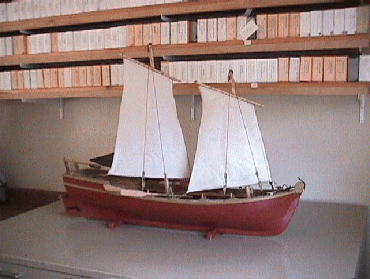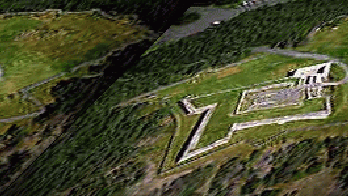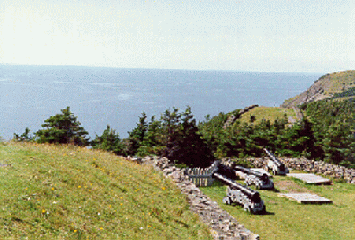ParksProject
Website Design and Content
© by Eric Krause, Krause House
Info-Research Solutions (© 1996)
All Images ©
Parks Canada Unless Otherwise Designated
Researching
the Fortress of Louisbourg National Historic Site of Canada
Recherche sur la Forteresse-de-Louisbourg Lieu historique national du Canada
Volume 5: Number 03

NATIONAL HISTORIC SITES
OF CAPE BRETON
LIEUX HISTORIQUES NATIONAUX DU CAPE-BRETON
Vol. 5, No.
03
March 2003 - mars 2003
New Chaloupe for the Fortress
Kenneth Cross, local boat builder and retired fisherman has produced a model of the l8th century fishing chaloupe. This model is on a scale of l inch to the foot is a copy of the boats used on site. Mr. Cross was the boatbuilder in charge of the chaloupe construction during 1995.

|
Curatorial, Conservation, Collection Management Workshop
Bill O’Shea attended the above workshop held in Toronto from March 24th to 26th. This is part of a national review of service centres. Meetings were held in the historic George Brown house north of Dundas street.
While in Toronto, Bill visited two of his sisters and a brother who live there.
Materiel Culture Specialists
During the last two weeks of March, four specialists in material culture from the Ontario Service Centre have been examining the archaeological collections. Phil Dunning, Chuck Bradley, Gerard Gusset and Peter Sattelberger identified wooden objects in the collection for research purposes and to aid in establishing conservation priorities.
They also conducted research in areas of curatorial interest including such diverse objects as beverage containers, horse harness, cart hardware, and powder flasks.
Kings’ Bastion Barracks Roof
Construction work on the King's Bastion Barracks has continued through the winter and although hampered by some of the most extreme weather in years, progress has indeed been made. All the existing slate has been removed from the roof except for the east elevation of the Officer's Quarters. New slate and lead chimney flashings are now being installed to the west elevation of the Officer's Quarters and work on the Governor's Wing roof and dormers will recommence in April. Scaffolding is currently being erected to the ten chimneys on the north end of the building, and chimney dismantling has now commenced on the west elevation of the Soldier's Barracks.
Construction is still expected to be completed by the end of this year. The current labour force on site is some 20 men.
Submitted by Philip Hoad
Jeanette Beaver, a local resident of Louisbourg has been working in the Archives with Heather Gillis since early February. Jeanette is under the auspices of the Ann Terry Project that helps women re-enter the workforce after an absence. We welcome Jeanette and wish her luck in obtaining full time employment when her term here is completed.
The competition for the historian position at Louisbourg has been completed and the candidates informed of the results. The new historian will be reporting for work soon.
There is an open competition currently being held for a Fireperson/Watchperson. This competition has now closed.
Jean Rene Bourgeois, Client Services Officer has accepted a position with Citizenship & Immigration. JR started at the Fortress in l978 as a costumed interpreter. He was an original member of the site’s music program and in 1999 he took on the duties of Programme Assistant. He has been Client Services Officer since 2001.
We wish JR all the best in the future - we will miss him.
Getting to Know our Parks

Castle Hill features the remains of French and English fortifications from the 17th and 18th centuries. Visitors can learn about the everyday life of the French fishermen and soldiers at Placentia, Newfoundland. The site also features a magnificent view of the town of Placentia and the surrounding harbour.
 During
the late 17th and 18th centuries, French and British forces fought sporadically
for control of Newfoundland, though the island's fate was still heavily
influenced by events in Europe.
During
the late 17th and 18th centuries, French and British forces fought sporadically
for control of Newfoundland, though the island's fate was still heavily
influenced by events in Europe.
Determined to control the Newfoundland fishery, the French chose Placentia, or "Plaisance" as they called it, for its excellent harbour and proximity to the Grand Banks. Here, they hoped to build a colony that would solidify their claim to a portion of the fishing rights around the island of Newfoundland.
Plaisance proved to be a poor choice for the French colonists. Despite successful fortifications at Castle Hill which allowed the French to fend off British attacks, Plaisance had serious problems. The British were able to blockade Placentia Bay fairly easily. The French colonists had limited access to basic supplies. The land itself was not good for farming, and yielded little in the way of crops or livestock. With no support infrastructure, and rivalries between resident and seasonal fishermen on the rise, the colony was destined to fail.
Today, the remains of France's 17th-century fortress at Castle Hill are all that is left of the French presence here. Events in Europe sealed Plaisance's fate when the British gained sovereignty over Newfoundland by the Treaty of Utrecht, leaving France with fishing rights to the northeast and west coasts. The French colonists and soldiers moved on to build the Fortress of Louisbourg in Nova Scotia. Castle Hill was fortified by the British for a brief period during the Seven Years' War, but Placentia was overshadowed by St. John's.
Castle Hill played a critical role in this chapter in Newfoundland's history, and in Europe's changing role in the New World.
Bill O’Shea, Manager, Cultural Resources here at Fortress of Louisbourg was the first Superintendent at Castle Hill. He served in this role from 1972 to 1974 where he too left Placentia to go to Louisbourg just like the French did!!
If you would like to make a submission to the Hear Ye! Hear Ye! Newsletter, please send information to Donna MacNeil at donna.macneil@pc.gc.ca, or phone 733-3551.